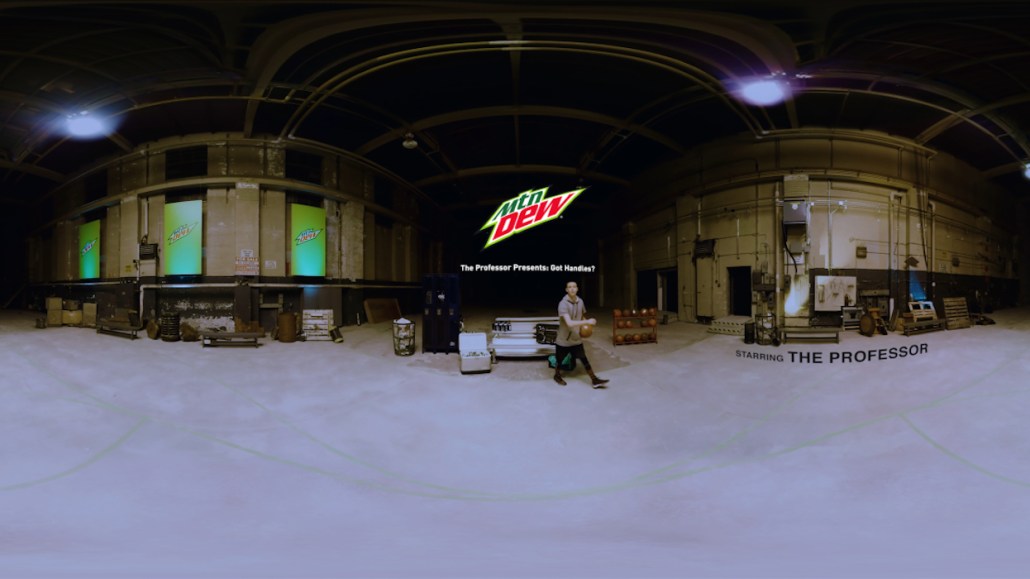
PepsiCo’s marketers for its Mountain Dew brand aren’t getting carried away after seeing a 360-degree video campaign from earlier this year generate more click-throughs than some mobile video campaigns.
Working with streetball star Grayson “The Professor” Boucher, Mountain Dew ran the #GotHandles campaign, a game that let fans try to complete a series of Boucher’s moves in virtual reality. To promote the game, which launched on Oculus, Samsung and HTC VR devices, the drinks company ran a 360-degree trailer across ad platform Immersv’s network of publishers that either sold 360-degree inventory or had a VR app, including Condé Nast and Meredith.
Mountain Dew’s video was viewed more than 100,000 times between July 31 and Aug. 31, according to Kate Brady, director of media strategy and consumer engagement at PepsiCo. More than six in 10 people (63 percent) who saw the ad completed it, and it had a 22 percent click-through rate, per Immersv. For comparison, the average click-through rate for mobile video ad campaigns is a mere 1 percent, according to research that video marketing platform Innovid conducted last year.
Despite this success, Brady and the rest of her team still have reservations about 360-degree ads, particularly regarding how they stack up against traditional videos. It’s hard to measure 360-degree campaigns against Mountain Dew’s efforts with standard mobile video formats, Brady said. The brand plans to run more tests over the next 12 months to find out whether it can ensure higher engagement metrics for 360-degree videos than for standard mobile videos. Questions also exist about when 360-degree ads should be used, given the costs of creating them versus that of standard mobile video campaigns.
It’s difficult to compare traditional video with 360-degree video, as the ad format is completely dependent on the audience, how the audience consumes content, the brand, the category and the idea or content itself, said James Britton, global managing director at Stink Studios. “If you were targeting [retirees 65 or older], then traditional video might be more effective, whereas if you were targeting teenage mobile gamers, then a 360 experience might be more effective,” Britton said. “But most importantly, it depends on what works best for the idea.”
Mountain Dew’s ongoing work with the video games industry, including with Microsoft Xbox and Sony PlayStation, is the clearest way for it to figure out whether there’s more to 360-degree ads than the hype. This is particularly true of whether that format could be used as a stepping stone to the more complex but potentially more rewarding VR ads.
The advertiser has nurtured partnerships with both Sony’s and Microsoft’s gaming consoles over the past several years and more recently has used those deals to explore VR. Mountain Dew started testing VR in early 2014 and has produced several campaigns that play with the format, ranging from full-blown experiences for products such as the Oculus Rift to earlier tests with 360-degree video on YouTube.
Brady said the soda brand would “lean in” further to VR ad campaigns moving forward, adding that VR will be an $80 billion market by 2025, so the advertiser is trying to get a foothold in the format now.
More in Media

Digiday+ Research: Publishers’ growing focus on video doesn’t translate to social platforms
Major publishers have made recent investments in vertical video, but that shift is not carrying over to social media platforms.

Technology x humanity: A conversation with Dayforce’s Amy Capellanti-Wolf
Capellanti-Wolf shared insight on everything from navigating AI adoption and combating burnout to rethinking talent strategies.

How The Arena Group is rewriting its commercial playbook for the zero-click era
The company is testing AI-powered content recommendation models to keep readers moving through its network of sites and, in doing so, bump up revenue per session – its core performance metric.








